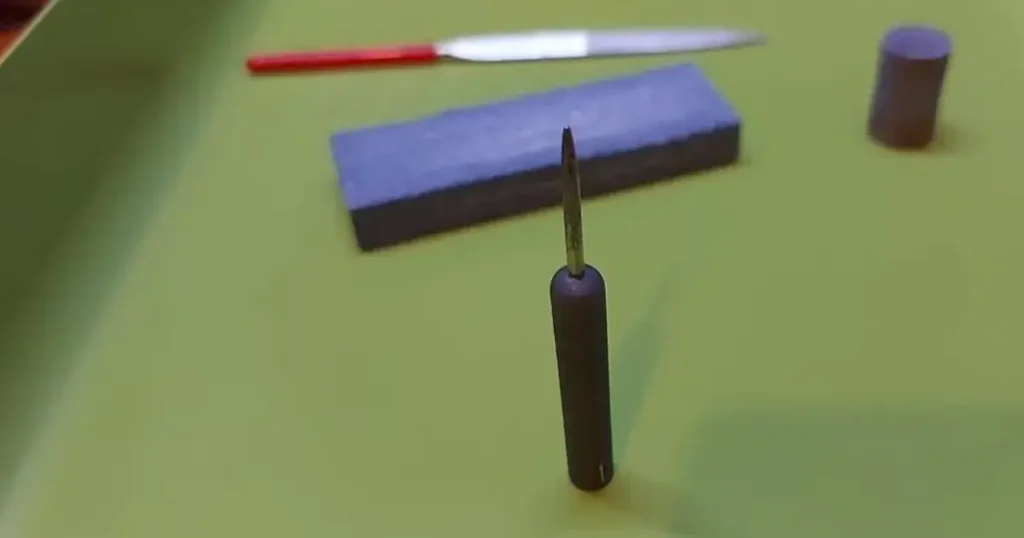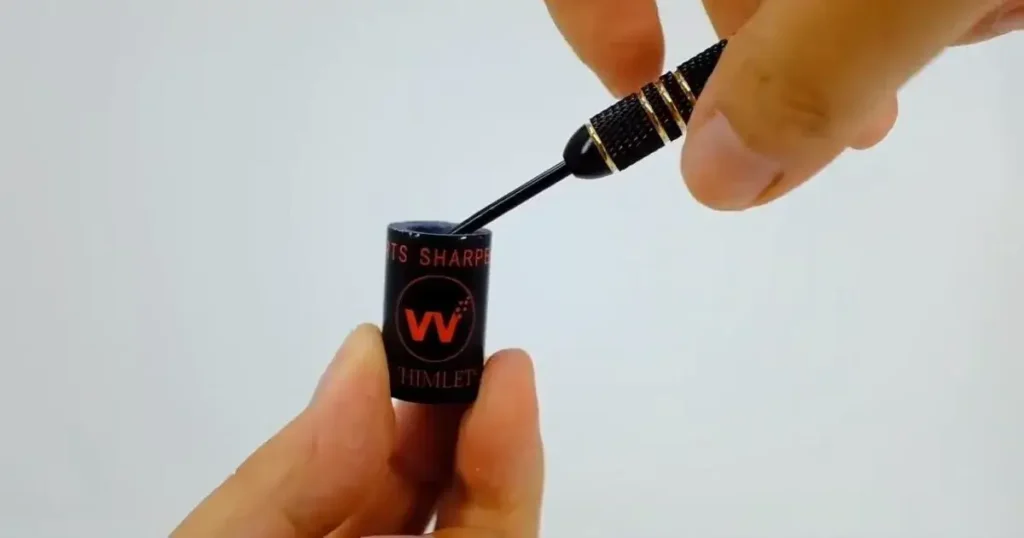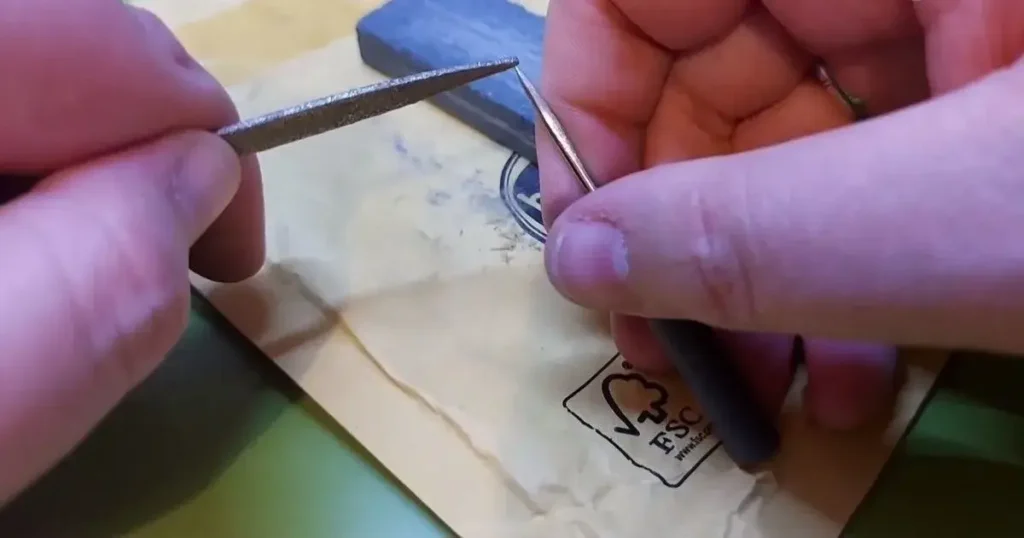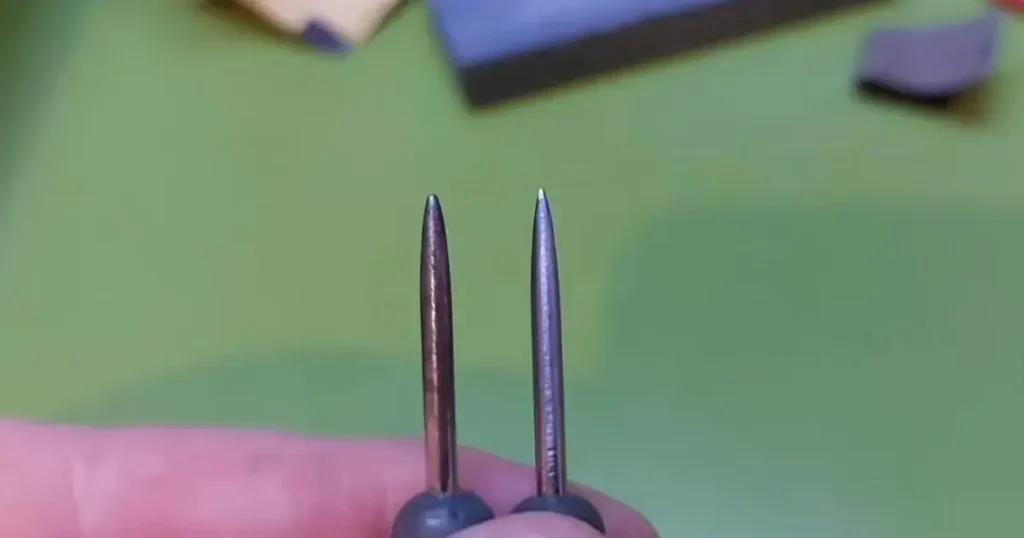Are you tired of constantly missing the bullseye when playing darts? Do you want to improve your game and impress your friends? Well, the solution may lie in the art of sharpening your darts.
In short, sharpening your darts involves refining the tip of the dart to make it sharper and more precise. By doing so, your darts will be more effective and your game will improve. In this article, we will guide you through the process of sharpening your darts, step-by-step so that you can achieve the perfect point.
To make sure you’re getting the most reliable information, we’ve consulted with renowned darts expert, John Lowe, who has over 40 years of experience in the game. By the end of this article, you’ll not only know how to sharpen your darts but also understand why it’s crucial for your game. So, grab your darts, and let’s dive in and improve your game!

Tools Needed
Dart sharpener or sharpening stone
A dart sharpener or sharpening stone is a necessary tool for sharpening darts. The sharpener typically consists of a cylinder with a sharpening surface on the inside and a clamp to hold the dart securely while sharpening. Sharpening stones are also used for the same purpose, but they require a bit more skill to use effectively. These tools are designed to create a sharp point on the dart tip, which is essential for accurate and consistent throws.
Safety equipment
When sharpening darts, it’s important to take safety precautions to avoid injury. The sharpening process can create sharp metal shavings that can be hazardous to the eyes and skin. Therefore, it’s recommended to wear gloves to protect your hands and eye protection to prevent debris from entering your eyes.
Additionally, it’s important to work in a well-ventilated area to avoid inhaling dust or fumes. By using the appropriate safety equipment, you can ensure that the sharpening process is both effective and safe.
Preparing the Dart
Before sharpening your dart, it’s important to remove the flights and shafts. The flights are the wings on the back of the dart that help stabilize it during flight, while the shafts connect the flights to the barrel. By removing them, you’ll have better access to the barrel for cleaning and sharpening.
To remove the flights and shafts, gently twist them and pull them out of the barrel. Be careful not to damage them, as they can be fragile.
Cleaning the dart
Once you’ve removed the flights and shafts, it’s important to clean the dart. This helps to remove any debris or dirt that may have accumulated on the barrel. Use a soft cloth or brush to gently clean the surface of the dart, taking care not to scratch or damage it. You can also use a mild soap and water solution to clean the dart, but be sure to dry it thoroughly afterward.
Examining the dart for damage
After cleaning the dart, take a close look at it to see if there are any signs of damage. Look for cracks, chips, or other signs of wear and tear that may affect the dart’s performance. If you notice any damage, it’s best to replace the dart rather than try to repair it.
Even small imperfections can cause the dart to fly off course or miss the target, so it’s important to ensure that your darts are in good condition before sharpening them. By examining your dart for damage, you can ensure that you’re using darts that are safe and effective.

Sharpening the Dart
A well-sharpened dart will have a sharp, accurate point that allows it to stick to the board and improve your accuracy. We’ll go over the steps to sharpen your dart effectively.
Holding the dart securely
Before sharpening your dart, it’s important to hold it securely. This will help ensure that the sharpening process is accurate and effective. Hold the dart by the barrel with your non-dominant hand, and grip the dart sharpener or sharpening stone with your dominant hand.
Choosing the right angle
Choosing the right angle is essential for sharpening your dart effectively. The angle you choose will depend on the shape and size of your dart tip. In general, a 45-degree angle is a good starting point. However, you may need to adjust the angle based on the shape of your dart tip.
Using the dart sharpener or sharpening stone
Once you’ve chosen the right angle, it’s time to use the dart sharpener or sharpening stone. Place the dart in the clamp or holder of the sharpener, and then gently run the tip of the dart along the sharpening surface. Apply light pressure and make sure to maintain the angle you’ve chosen. Repeat this process several times, gradually applying more pressure with each pass.
Checking the sharpness of the dart
After sharpening your dart, it’s important to check the sharpness of the tip. You can do this by gently running your finger along the tip of the dart. If it feels sharp and smooth, then you’re done. However, if it feels dull or rough, you may need to repeat the sharpening process. Remember to be careful when handling the sharp tip of the dart. By checking the sharpness of the dart, you can ensure that it’s ready for use and will improve your accuracy on the dartboard.
Reassembling the Dart
Now that you’ve sharpened your dart and examined it for damage, it’s time to reassemble it. This is an important step in ensuring that your dart is balanced and performs optimally. Now we’ll go over the steps to reassemble your dart effectively.
Reattaching the flights and shafts
The first step in reassembling your dart is to reattach the flights and shafts. Gently insert the shaft into the barrel, making sure that it’s straight and secure. Then, slide the flight onto the shaft and push it up against the barrel. Repeat this process for the other two flights and shafts. Be careful not to damage the flights or shafts during this process, as they can be fragile.
Checking the balance of the dart
Once you’ve reattached the flights and shafts, it’s important to check the balance of the dart. A balanced dart will fly straight and true, while an unbalanced dart may veer off course. To check the balance of your dart, hold it by the barrel with your fingers and let it hang freely.
The dart should hang straight and level. If it doesn’t, adjust the flights or shafts until it does. You may also want to experiment with different combinations of flights and shafts to find the best balance for your throwing style.
Maintenance Tips
Maintaining your darts is essential to ensure that they perform at their best and last for a long time. Regular maintenance involves not only sharpening your darts but also proper storage and careful handling.
How often to sharpen your darts
The frequency of sharpening your darts will depend on how often you use them. Generally, it’s recommended to sharpen your darts after every few uses. However, avoid over-sharpening your darts, as this can cause them to become too thin and break more easily. It’s important to maintain the right balance between sharpness and durability.
Proper storage of darts
Proper storage of your darts is crucial to avoid damage and ensure their longevity. You can use a dart case or wallet to keep your darts organized and protected. When not in use, make sure to keep the dart tips covered to prevent accidental injury. Also, keep your darts in a cool, dry place to prevent damage from moisture or heat.
Tips for avoiding damage to your darts
To avoid damaging your darts, handle them with care. Avoid dropping your darts or throwing them at hard surfaces, as this can cause damage to the tips or flights. When storing your darts, keep them away from other sharp objects or materials that could scratch or damage them. When removing the darts from the board, be careful not to bend or break the shafts.
Final Tips
Sharpening your darts is a skill that takes practice and patience to master. To help you achieve the best possible results, here are some final tips for sharpening your darts like a pro:
- Take your time: Don’t rush the sharpening process. Take your time to ensure that the tip is evenly sharpened and that you don’t remove too much material.
- Use the right tools: Use a dart sharpener or sharpening stone specifically designed for sharpening darts. Avoid using ordinary sharpening tools as they may not be suitable for the job.
- Keep your darts clean: Make sure your darts are clean before sharpening them. Dirt and debris can damage the sharpening tool or affect the sharpness of the dart.
- Test the sharpness: Always test the sharpness of your dart after sharpening it. Use a piece of paper or cardboard to test the sharpness of the dart tip.
- Practice regularly: Sharpening your darts is a skill that requires practice. The more you practice, the better you will become at it.

What Do I Look For In A Dart Sharpener?
When searching for a dart sharpener, there are several factors to consider. Firstly, the type of sharpener – whether it’s a stone, file, or diamond sharpener – will affect the sharpening process and the final result. Additionally, the size and weight of the sharpener may impact its portability and ease of use. Durability and longevity are also crucial factors to consider, as a sharpener that quickly becomes dull or wears out will not be a worthwhile investment.
Finally, the cost is an important consideration, as some sharpeners may be more expensive than others. Ultimately, the best dart sharpener for an individual will depend on their specific needs and preferences.
Different Types of Dart Sharpener
When it comes to sharpening your darts, there are several types of dart sharpeners available on the market. Each type has its own unique features and benefits. Let’s take a closer look at some of the most common types of dart sharpeners.
- Dart Sharpening Stone: This is the most traditional type of dart sharpener, and has been used for decades. These sharpening stones are typically made from high-quality materials such as diamond or ceramic and are designed to sharpen the tip of your dart to a fine point.
- Electric Dart Sharpener: If you’re looking for a faster and more efficient way to sharpen your darts, an electric dart sharpener might be a good choice. These sharpeners use a motor to quickly sharpen the tip of your dart and are often equipped with various settings for different levels of sharpness.
- Tungsten Dart Grinder: This type of sharpener is specifically designed for tungsten darts, which are becoming increasingly popular among serious dart players. These grinders use a special diamond wheel to sharpen the tip of your tungsten dart to a razor-sharp point.
- Dart Point Files: These files are similar to traditional sharpening stones, but are designed specifically for dart points. They often have a curved shape, making them easier to use on the small and precise tip of a dart.
What Happens When Your Darts Are Too Sharp?
Overly sharp dart points can cause issues for players, including bouncing out of the board, damage to the dartboard, or injury to other players. Sharpness regulations may exist in some leagues or tournaments to prevent unfair advantages. It’s crucial for players to find a balance in the sharpness of their dart points to avoid these issues.
For example, if a player’s darts are too sharp, they may penetrate the dartboard too deeply and cause damage to the board or even the wall behind it. Additionally, the sharp points may be prone to bouncing out of the board, resulting in lost points and frustration for the player.
In extreme cases, overly sharp points may cause injury to other players if they accidentally come into contact with them. Therefore, it’s essential for players to ensure their darts are sharp enough to stick to the board but not so sharp as to cause harm or damage
What Happens When You’ve Got Blunt Dart Tips?
Blunt dart tips can have a significant impact on the accuracy and consistency of your throws. When the tips are dull, they are more likely to bounce off the board instead of sticking, which can result in lower scores and frustration. Additionally, blunt tips can cause damage to the dartboard, as the force of the throw can cause the dart to bounce back and hit the board at an angle.
This can cause the board to wear out more quickly, leading to the need for more frequent replacements. Furthermore, the dart itself may also sustain damage, such as bent or broken flights or shafts. In order to avoid these issues and maintain optimal performance, it’s important to regularly sharpen your darts to ensure their tips are sharp and pointed.
What If Your Dart Has Burrs?
If your dart has burrs, it can cause several problems during gameplay. Burrs are rough, uneven areas on the surface of the dart tip that can make it difficult to aim and stick to the dartboard. When the dart hits the board, burrs can catch on the fibers of the board, causing the dart to bounce off or not stick at all.
Additionally, burrs can damage the board and cause excessive wear and tear, leading to more frequent replacements. To address this issue, it’s important to use a dart sharpener or sharpening stone to remove the burrs and smooth out the surface of the tip. Regular maintenance of your darts can help prevent the development of burrs and ensure optimal gameplay.

FAQ
Why is it important to sharpen darts?
Sharpening your darts can improve their accuracy, making them easier to throw and increasing your chances of hitting the target.
What tools do I need to sharpen my darts?
You’ll need a dart sharpener or sharpening stone, as well as safety equipment like gloves and eye protection.
What’s the best way to hold a dart while sharpening it?
It’s important to hold the dart securely and avoid putting too much pressure on the tip. Many dart sharpeners come with a clamp or holder to help with this.
How often should I sharpen my darts?
The frequency of sharpening can depend on how often you use your darts, but many players recommend sharpening them every few weeks or at least once a month.
Can I damage my darts by sharpening them too much?
Yes, over-sharpening your darts can cause them to become too thin or brittle, which can affect their performance. It’s important to follow the recommended sharpening frequency and techniques to avoid damaging your darts.
Final Thought
Sharpening your darts is an important aspect of maintaining their quality and performance. With the right tools and techniques, anyone can sharpen their darts like a pro. By following the steps outlined in this article, you can improve your dart game and increase your chances of hitting the bullseye.
However, it’s important to remember that dart maintenance doesn’t stop at sharpening. Regular cleaning, proper storage, and careful handling are all crucial components of keeping your darts in top condition.
By taking the time to properly care for your darts, you can ensure that they’ll be a reliable tool for years to come. So, get ready to step up your dart game and show off your newly sharpened darts!


